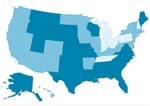government
ACA Medicaid expansion analyzed by cost burden to patients
■ States vary widely in terms of the portions of poor residents who are without Medicaid and who also face high out-of-pocket costs.
Washington States with the largest shares of low-income people who have high medical cost burdens would benefit the most from expanding their Medicaid programs under the health system reform law, a report conducted by the Urban Institute for the Robert Wood Johnson Foundation concluded.
In late March, the federal government issued a final rule that detailed its plans to offer full assistance to states that expand eligibility for their Medicaid programs up to an effective rate of 138% of the poverty level under the Affordable Care Act. The 100% federal match rate would cover all of the costs of caring for the newly eligible for the first three years of expansion, with states eventually taking on up to 10% of the expansion costs. The rule also outlined the availability of increased federal assistance for states that already had expanded their Medicaid programs to certain adults before the reform law’s enactment.
In assessing the financial burden of medical spending in each state, the report identified the states with the biggest shares of low-income people who don’t have Medicaid coverage and who face the highest out-of-pocket cost burdens — the states that researchers said would benefit the most from expansion. The researchers defined high medical burden as medical spending rates as a portion of income that were in the top 25% nationwide.
“Not surprisingly, the poor pay a large share of their resources to access health care,” said Kyle J. Caswell, PhD. He’s the lead author of the report and an economist and a research associate at the Urban Institute’s Health Policy Center. “However, the burden levels vary considerably from state to state.” Eight percent of Nevada’s nonelderly constituents, for example, are low-income, face high medical spending burdens and are without Medicaid. At the other end of the spectrum is Vermont, where only 3% of the population have these characteristics.
The report’s researchers also found variations among the regions, with poor residents of Middle Atlantic states seeing the lowest medical spending burdens. East South Central and Mountain states had higher out-of-pocket cost burdens.
Some high-burden states not expanding
Caswell said state officials could alleviate these out-of-pocket cost burdens on constituents by agreeing to expand Medicaid eligibility, “which will enable people with limited resources to access health care at no or very low cost.” But unlike Nevada, whose leaders decided this year to expand its program starting in 2014, not all of the states with the biggest shares of poor individuals with high cost burdens have decided to do so.
Louisiana and Mississippi, for example, the states with the second- and third-highest share of these individuals, respectively, have no plans to expand their programs next year. Of the top half of the state list compiled in the report, nine states have said they will not expand Medicaid, whereas 10 said they would participate in expansion. Six states remained undecided.
Not all physicians have backed the concept of expanding Medicaid. In a recent advocacy paper, Jeff Williams, executive vice president and CEO of the Louisiana State Medical Society, said his organization’s members did not support extending the state’s Medicaid managed care program, Bayou Health, primarily because it was laden with administrative burdens and budget shortfalls.
Williams wrote that Bayou Health needed substantive reforms, such as more reasonable and timely payments to doctors who treat Medicaid patients. Funds that would have been used to expand Medicaid instead should be reallocated in the form of premium support payments to help low-income individuals and families buy private insurance, he suggested.












